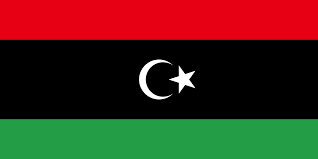28 May 2020
Libya
is not Syria.
By Neil Tidmarsh
 This week, the civil war in Libya showed signs of escalating out of control. The Turkish-backed forces of the Tripoli-based GNA (Government of National Accord) recaptured the al-Watiya airbase from the Russian-backed forces of the Benghazi/Tobruk-based LNA (Libyan National Army). Defeated LNA fighters withdrew from the front line around Tripoli, retreating south to rear bases in the desert. Turkey and Russia called on their clients to agree a ceasefire but were ignored. It now seems that Russia is doubling down on its support for the LNA by sending fighter jets to Libya.
This week, the civil war in Libya showed signs of escalating out of control. The Turkish-backed forces of the Tripoli-based GNA (Government of National Accord) recaptured the al-Watiya airbase from the Russian-backed forces of the Benghazi/Tobruk-based LNA (Libyan National Army). Defeated LNA fighters withdrew from the front line around Tripoli, retreating south to rear bases in the desert. Turkey and Russia called on their clients to agree a ceasefire but were ignored. It now seems that Russia is doubling down on its support for the LNA by sending fighter jets to Libya.
Stephanie Williams, the UN envoy for Libya, told the UN security council that the recapture of al-Watiya was “a turning point” in the conflict, pushing it towards “a pure proxy war”.
Indeed, it’s tempting to see this proxy war as an extension of that other proxy war – Libya as Syria Part II. With the vicious war of attrition in Syria grinding to a halt, Turkey and Russia are now squaring up to each other in a new arena. The recent GNA victories are due in no small part to the men and materiel transferred by Turkey from Syria to Libya. Turkish-paid mercenaries and rebel groups recently fighting against Assad are now fighting against the forces of Marshal Kalifa Haftar, the leader of the LNA. Turkish drones appear to have tipped the war in the GNA’s favour.
Similarly, Marshal Haftar’s LNA is supported by men and material provided by Russia. Thousands of Russian, Sudanese and Syrian mercenaries, recently fighting for Assad, are now fighting for the Marshal. What really put the fall of al-Watiya in the news this week was the seizure and destruction of a number of Russian-made Pantsir missile systems, the retreat of the infamous Russian mercenary outfit the Wagner Group and the arrival in Libya of Russian fighter jets from an airbase in Syria (where, according to the Pentagon, they were repainted to hide their origins).
It would be a mistake, however, to see the Libyan conflict as an extension of the Syrian conflict. The issue at the centre of the war in Libya is quite different from the issue at the centre of the war in Syria. This difference is quite remarkable, largely unreported and of great significance to the Middle East and to the Islamic world as a whole.
The war in Syria, initially a rebellion against Assad’s repressive regime, became a stage for the region’s two would-be super-powers – Saudi Arabia and Iran – to slug it out for supremacy in the Middle East. Iran, being the region’s Shia power, backed the Shia regime of Assad; Saudi, being the region’s Sunni power, backed the largely Sunni opposition to Assad. The struggle developed along Shia v. Sunni sectarian lines, with the Sunni power Turkey backing the rebels alongside Saudi, and the Shia militias of Iraq supporting Assad alongside Iran. (Russia’s involvement is a matter of global power politics rather than regional sectarianism; Moscow backs the anti-West, anti-USA Iran and Assad in their opposition to the pro-West, pro-USA Saudi and the Sunni Gulf States.)
But the conflict in Libya isn’t the Sunni v. Shia conflict. It’s a conflict between two opposing and hostile camps within the Sunni world. One camp is occupied by ‘establishment’ Islam, upheld by conservative, autocratic, hierarchical regimes such as Saudi Arabia; the other camp is occupied by revolutionary ‘political’ Islam, by the ‘populist’, grass-roots movements of Islamist groups best exemplified by the Muslim Brotherhood.
Revolutionary political Islam triumphed momentarily in Egypt when popular protests overthrew President Mubarak in 2011 and the Muslim Brotherhood were elected; establishment Islam recovered power in Egypt, however, with the coup against the Muslim Brotherhood by President Sisi and the army two years later. Regimes like those in Egypt and Saudi Arabia continue to persecute the Muslim Brotherhood, but it hasn’t been driven underground throughout the whole of the Middle East; it has an office in Qatar and a champion in President Erdogan of Turkey (his AKP party reputedly shares common ground with the Brotherhood). It was Qatar’s support of the Brotherhood, as much as its relationship with Iran, which prompted Saudi Arabia and other Gulf States to turn their fury on Qatar three years ago. Saudi’s visceral hatred of the Brotherhood explains Riyadh’s persecution of the exiled Saudi journalist Jamal Kashoggi; he was a sympathiser of the Brotherhood, perhaps even a member of it. Turkey’s support of the Brotherhood explains why Kashoggi’s murder by Saudi operatives in Turkey – in Istanbul, the pro-Brotherhood Erdogan’s own backyard – was so explosive.
This conflict is at the heart of Libya’s civil war and can be seen most clearly there. After the fall of General Gaddafi, Libya became a chaotic and anarchic battleground between competing groups of jihadists, Islamists and other militants. That chaos persisted in the western half of the country, in spite of the installation of the Government of National Accord (which has never had much authority outside Tripoli itself). Indeed, the GNA has provided a home for a number of Muslim Brotherhood affiliated groups and other revolutionary Islamists which have joined it from Libya Dawn (a loose alliance of militias, militant Islamist groups and other factions which enjoyed a measure of authority in the region before being absorbed into the GNA).
In the eastern half of the country, however, that chaos and anarchy has largely been eradicated by the military and diplomatic initiatives of Marshal Haftar and the LNA acting on behalf of the government based in Banghazi / Tobruk. Haftar has a hatred of the Islamist groups he has been fighting for the last decade, which is why he has refused to have anything to do with the GNA in the past and why he is trying to overthrow it now. He has no time for the type of revolutionary political Islam represented by the Brotherhood and by other groups in Western Libya and would presumably like to rebuild Libya along the conservative, establishment, authoritarian lines of Saudi Arabia. His government supported the Gulf states’ Saudi-led attempt to isolate Qatar.
It becomes even clearer as soon as one takes a closer look at the proxies supporting either side of the war. Turkey supports the GNA because of its Brotherhood affiliates; Saudi (Turkey’s ally in Syria, its fellow Sunni supporter of the rebels against Assad’s Shia regime) is now on the opposing side, supporting Marshal Haftar’s LNA. Haftar is also supported by Egypt and the UAE, who share his and Saudi’s hatred of the kind of political Islam represented by the Brotherhood.
In fact, perhaps the only similarity with Syria is Russia’s position. As in Syria, Russia’s involvement is a matter of global power politics rather than regional sectarianism; the UN-recognised GNA is largely Western-backed, so Moscow has chosen the opposite side in its attempt to exploit the chaos of Libya to establish influence in North Africa. A military Strong Man like Haftar has an obvious appeal to the Kremlin. Presumably he shares Moscow’s (and Egypts’s and Saudi’s) lack of enthusiasm for the kind of liberal, secular and democratic freedoms which the UN has been struggling to introduce via the GNA in Tripoli.
There are signs, however, that Moscow is finding Haftar to be an even more intractable and uncooperative client than Assad. He walked out of peace talks organised by President Putin in Moscow four months ago and he ignored Russia’s call for a cease-fire last week. There are rumours that Putin is looking for an alternative leader in Libya and is even considering transferring his patronage to Saif al-Islam Gaddafi, the son of General Gaddafi.
It looks as if President Putin’s attempt to build a power base in North Africa via the chaos of civil war in Libya will be even messier and more uncertain than his attempt to build a power base in the Middle East via the chaos of civil war in Syria. But that will remain largely an irrelevance in the context of the sectarian struggle between revolutionary political Islam and establishment Islam which has at last found a battlefield where they can fight it out in open warfare.
(Confused by the chaos in Libya? See two previous articles, The Land of Three Governments and General Haftar on the March, for clarification.)


